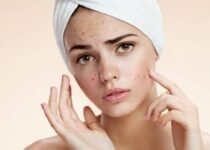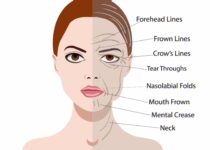How To Even Out Uneven Skin Tone
Uneven Skin Tone
You will never know how fortunate you are to have clear and even complexion until it’s gone. Once you start to see those little dark spots on your skin, don’t panic. First, you have to know what caused your uneven skin tone, and from there, you can identify how to even out uneven skin tone with treatments or products.
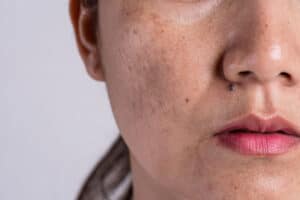
What is Uneven Skin Tone
When the production of melanin in your body is normal, the melanin would be enough to darken your hair, eyes, and some parts of your skin. There would also be an even color throughout your skin. But when there is an overproduction of melanin, the tone of your skin would become uneven in certain affected areas. Excess production of melanin is also one of the reasons why your skin will experience hyperpigmentation. On the same note, uneven skin tone is essentially hyperpigmentation itself.
Hyperpigmentation is a skin condition where dark spots or patches appear due to excess melanin, and uneven skin texture, dryness in the skin. Basically, melanin is responsible for the dark pigment you have in your hair, eyes, and other parts of the skin. If you notice dark spots on an area of your skin, it just means that your skin is overproducing melanin in that area.
As a result, our skin would have darker spots in some parts and lighter in others, which will then look like an uneven skin tone. Sometimes, hyperpigmentation and uneven skin complexion are symptoms of other illnesses, including underlying congenital diseases.
Most of the people who suffer from hyperpigmentation or uneven skin complexion don’t feel any physical pain. However, it can harm them mentally by dramatically affecting the appearance and self-esteem of the patient. The most common probable cause of why your body is forced to increase the production of melanin is due to its response to solar damage or UV rays that are caused by the sun.
Hormonal changes in the body are also one of the reasons why we experience an uneven skin tone. Don’t get me wrong I mean the intention of melanin is pure, which is to give protection and aid, but sadly the negative side can cause an uneven skin tone. Most cases of an uneven skin tone are usually curable whatever the cause of it: hyperpigmentation, exposure to the sun, unhealthy diet, acne scarring, or congenital disease or condition.
So as you can see, uneven skin tone isn’t only due to hyperpigmentation. Rather there are also other causes of it such as exposure to the sun, unhealthy diet, acne scarring, congenital disease, or conditions, hereditary skin conditions, dark spots, and lifestyle choices.
What Causes Uneven Skin Tone?
- Sun exposure
This is the most common cause of having an uneven skin tone which makes everybody disappointed since we love to go out on a sunny day. When our skin gets in contact with the sun, the UV rays will immediately harm your skin. In order to protect your skin from harmful UV rays, your body will produce melanin to protect our skin from it. Aside from having an uneven skin tone, sun damage can present itself in a variety of harmful ways, including sunburn and peeling, skin dryness, and the darkening of freckles.
- Free Radicals
Though you cannot see them, free radicals also can be a cause of having an uneven skin tone. These free radicals such as smoke, dust, pollution, chemicals, and any other will seep into our skin’s pores. Once they are inside, your body will automatically react and will go on defensive mode against them. When this happens, your body will produce excess melanin in order to protect your body against free radicals.
- Skin inflammation
Skin inflammation is caused by acne or any other forms of injuries to the skin such as cuts, flare-ups, burn, eczema, and many different reasons. When the skin goes through a healing process, the body will produce excess melanin which then will help cure the damaged skin. When the skin heals from the inflammation, extra melanin is created to aid the body in its recovery. As a result, the affected area is discolored, which is usually permanent, though skin discolorations can fade over time. Excess production of melanin will suddenly cause an uneven skin tone.
- Hormonal changes
Hormonal changes can cause uneven skin tone as well, especially those who are pregnant or on some form of contraceptive. When there is a major change in hormones, the production of melanin would be triggered. Another word for all of this is melasma. Unlike the usual sighting for uneven skin tones like the legs and arms, melasma, or chloasma, is a dark patch of skin that appears over the cheeks, nose, upper lip, and the chin. It is less commonly found in other areas of the body like the legs and the arms that are frequently exposed to the sun. 1 out of ten, those that are affected by melasma are men, as women are much more likely to cultivate this condition, often during pregnancy. Others might even call it the mask of pregnancy for it is caused by a change in hormones together with other factors.
- Age Spots
Age spots or also known as liver spots, dark spots, and sunspots are dark patches caused by the sun together with aging. The combination of harmful UV rays and aging makes age spots a formidable foe. This will tend to darken over time and are most evident when we are older. Usually, you can notice and find age spots in areas that have been most exposed to the sun over many years, on the face, shoulders, hands, arms, and chest.
- Vitiligo
This reason is in contrast to hyperpigmentation. Vitiligo is a skin condition that results in the loss of pigmentation of the skin. When the cells that are in charge of producing melanin suddenly stop making it, the effect would be having a lighter skin that appears in spots anywhere in our body, causing uneven skin tone.
- Fungal or Bacterial Infections
Uneven skin tone can also be caused by a fungal or bacterial infection such as ringworms, tinea versicolor, or candida infections. Fungal or bacterial infections can give discoloration to wherever it affects the skin because it goes inside and infects your skin’s scrapes, cuts, and other openings on the skin. The infected area would give a change of color and texture to your skin which causes uneven skin tone.
Is There A Difference Between Hyperpigmentation And Uneven Skin Tone?
Uneven skin tone is those blotchy, spotted, or inconsistent colored areas on your skin while hyperpigmentation is one of the causes that lead to uneven skin tone.
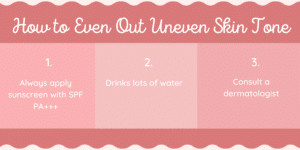
How To Get An Even Skin Tone?
- Always apply sunscreen SPF PA +++
Unprotected sun exposure is the number one culprit behind hyperpigmentation. Applying sunscreen or moisturizer with a Broad Spectrum SPF is the easiest way to help prevent new spots.
- Drink lots of water
Drinking water for at least 8 – 10 glasses a day will help our body get rid of skin toxins. Although some people don’t take it seriously or they disagree with this, drinking water is a must to our body. Reports show that by increasing their water intake, their skin now has a more radiant glow.
- Consult a dermatologist
Consulting a dermatologist is the most practical way to solve severe uneven skin tone. The experts will help you with your skin problem, and they will know which treatment procedure is to be used for your skin.
Treatments for Uneven Skin Tone
There are a lot of ways to treat uneven skin tone. There are ingredients you can use and treatment procedures that you can undergo to get your skin problem fixed.
- Treatment Procedures
Before doing any treatment procedures, you have to make sure that a dermatologist or a licensed aesthetician is going to handle you. Double-check if the clinic is legit. You want everything to be secured and avoid any further problems ahead, for your skin and for your safety too.
- Laser skin resurfacing
This process is done by having an intense beam of light energy pointed directly at the uneven skin. The beam of light will destroy the epidermis, which is the outer layer of your skin, but at the same time, it will also heat the underlying skin which we call the dermis. When the dermis is heated at an exact temperature, our body will stimulate collagen production over time which will result in a better skin tone and texture.
- Dermabrasion
This treatment requires a shed technique and a rotating instrument that will be in charge of removing the epidermis. Dermabrasion is usually done on the face and is a very popular treatment method for people who wish to have an improved appearance for their skin. It does not only heal uneven skin tone, but rather it also treats fine lines, acne scars, and uneven textures.
- Chemical Peels
The method of this cosmetic treatment is the same as Dermabrasion where it also exfoliates the skin. The difference between the two is that chemical peels use an acid which can remove a uniform amount of damaged skin cell within the focused area.
- Facials
This is basically the most well-known method and the best way of treating our skin. A facial does it all, it cleanses, exfoliates, and nourishes the skin, which will result in a well-hydrated complexion and can moisturize our skin which makes it look and feel young.
- Microdermabrasion
Microdermabrasion uses minute diamond tips or fine crystals to rub the skin and vacuums suction which in return will remove dead skin cells. The difference between microdermabrasion and dermabrasion is that microdermabrasion only makes subtle changes and doesn’t cause skin color changes or scarring. It also doesn’t work on deeper problems such as scars, stretch marks, wrinkles, or deep acne scars.
- Microneedling
The method of micro-needling is slightly painful. This kind of treatment works by forcing our skin to make more collagen by causing slight injury to the skin through pinpricks. When the slight injury is done, the skin will respond by producing new collagen-rich tissue which can even skin tone and texture.
Is There Any Ingredients That Can Help Even Out Uneven Skin Tone?
Honestly, treatment procedures cost a heck ton of money and need high maintenance. If treatments is not your cup of tea, you can opt to use products with ingredients that help in treating uneven skin tone.
Here is a quick list of ingredients to consider:
- Hydroquinone
- Tretinoin
- hyaluronic acid
- cortisone
- Vitamin C
Of all the above ingredients, I personally would advise going for gentler ingredients such as hyaluronic acid product and vitamin C when it comes to applying products on the face. As a Korean skin care lover, I personally prefer to keep the skin hydrated, use of sunscreen and skin-friendly products to even out less severe uneven skin tone.
If you have severe uneven skin tone issue, I would advise seeking dermatologist advice before using stronger ingredients for the cure.
If you have less severe skin tone issue, you may try on Korean skin care and test whether it is suitable for you.
Korean Products To Treat Uneven Skin Tone
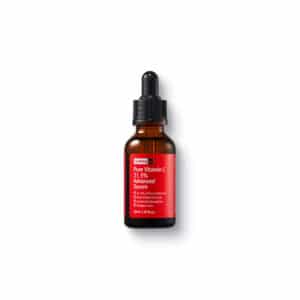
This high concentration vitamin ampoule is made with 70% Vitamin Tree Water and 21.5% Pure Vitamin C to deliver the concentrated effects of vitamin C to the skin. Wishtrend Pure Vitamin C 21.5 serum removes dead skin cells to even out the skin tone and brightens the complexion.
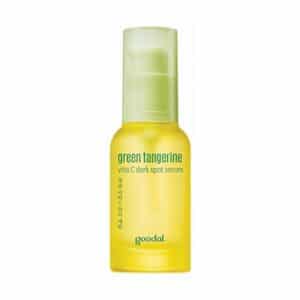
A hypoallergenic serum packed with 70% of Vitamin C from green tangerine rids improves the appearance of blemishes, freckles and other dark spots. Goodal Green Tangerine Vitamin C Dark Spot Facial Serum is dewy and gel-like texture is non-sticky and leaves a refreshing feeling. Use after cleansing.
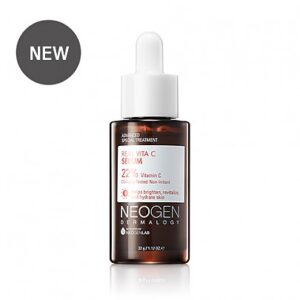
Enriched with 22% of sodium ascorbyl phosphate and niacinamide, Neogen Dermalogy Real Vitamin C Serum removes blemishes, brightens dull skin tone, and nourishes tired skin to reveal a healthy-looking complexion. Also contains collagen and hyaluronic acid for moisturizing and smoothing effects, as well as citrus fruit extracts to revitalize skin. After cleansing, apply the product onto the face and neck area and spread gently for better absorption, making sure to re-apply a thin layer on areas with more blemishes.
